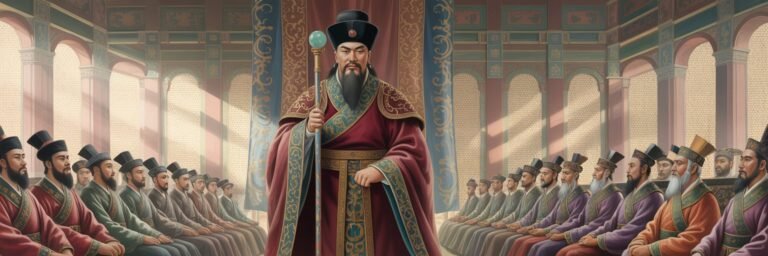INTRODUCTION
The annals of history are painted in the bloody hues of warfare. Intricate tapestries of conquest and loss enmesh in a testament to human strive and sacrifice. Among these, the Mongol Empire’s battles hold particular sway. Between the 12th and 13th centuries, the Mongols unleashed ferocious military campaigns, crushing kingdoms under their horses’ hooves and asserting their dominance across Asia and Europe. The Empire’s breathtaking sprawl, from Hungary’s fertile plains to China’s mountain-girded heartland, was built on the back of earth-shattering conflicts, leaving an indelible mark on the course of human history.
HISTORICAL BACKGROUND
The genesis of the Mongol Empire’s stupendous ferocity can be traced back to the charismatic leadership of Temujin, later known as Genghis Khan, who united disparate Mongol tribes under his banner in 1206. Central to the Empire’s unfettered expansion were its sundering military campaigns, where its superior horsemanship, innovative strategies, and sheer ruthlessness bellied a torrent of destruction. Two decisive and particularly sanguinary battles deserve mention: The Battle of Khwarezm and the Battle of Liegnitz.
The Mongol invasion of Khwarezm in 1219-1221 perhaps best embodies the Empire’s terrifying potency. This was not merely a conquest; it was annihilation. The Khwarezm Shah Ala ad-Din Muhammad II’s misjudged provocation by executing Mongol emissaries ignited Genghis Khan’s wrath. He didn’t want a win; he thirsted for an oblivion.
THEORIES AND INTERPRETATIONS
Mainstream historical interpretation suggests that Genghis Khan’s devastating assault on Khwarezm, apart from enforcing a brutal strategic calculus, was intended as a shockingly visceral message to other potential adversaries. The onslaught alienated and shattered enemy morale, making subsequent conquests sail on the waves of dread stoking the enemy’s hearts.
However, an alternate theory posits that Mongol campaigns, while undeniably brutal, were calculated maneuvers aimed at cementing the Empire’s economic supremacy. The destruction wasn’t mindless savagery but a draconian form of Realpolitik aimed at complete regional control. The Mongol Empire sought to control Silk Route trade, which would be unlikely without its southward expansion.
MYSTERIES AND CONTROVERSIES
Controversy surrounds the death toll of the Mongol invasions. In Khwarezm alone, estimates range between a staggering two million to a horrifying sixteen million. Modern scholars have challenged these death tolls arguing that they may have been inflated, but the lack of comprehensive records from the period makes a definitive answer elusive. An enduring mystery surrounds their warfare technique – the feigned retreat.
SYMBOLISM AND CULTURAL SIGNIFICANCE
Symbolically, the Mongol Empire’s wars represent the tragedy and irony of human civilization – that brutal conquests have often paved the way for cultural exchanges. The Empire’s relentless expansion precipitated the Mongol Pax or Pax Mongolica, leading to an unprecedented era of peace, which in turn facilitated the diffusion of ideas, technologies, and goods, irrevocably altering the human narrative.
MODERN INVESTIGATIONS
Modern studies have sought to comprehensively understand the Mongol Empire’s military strategies and their impacts on its conquered territories. Archaeological investigations are delving into the material culture of the Mongol period, while anthropological studies are deconstructing societal changes impelled by Mongol invasions.
Studies also reveal the environmental impact of this period. A 2011 study suggested Mongol invasions might have prompted a global cooling event by depopulating entire regions and allowing forests to regrow, absorbing significant amounts of carbon dioxide.
Additionally, recent textual analysis of Mongol law, the Yassa, reveals a systemic approach to warfare backed by clear rules, belying the image of the Mongols as mere savages.
LEGACY AND CONCLUSION
The Mongol Empire’s military conquests left a profound impact on the world, establishing connections between the East and the West. Its brutal yet pragmatic military strategies influenced countless future campaigns and shaped the idea of total war.
Controversies, theories, and mysteries notwithstanding, the Mongol Empire’s battles remain an emblem of the old saying: history is harsh but illuminating, teaching hard lessons with the quill dipped in blood. Its blood-soaked battlefields are silent now, whispering forgotten tales of death and destruction, power and perseverance. Yet, their echoes reach us, a guttural, sobering reminder of the fragile paradox that is human civilization, built on the corpses of the fallen, even as it ascends to the stars.






